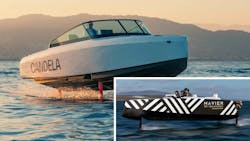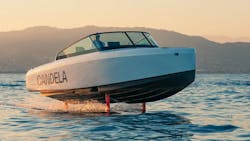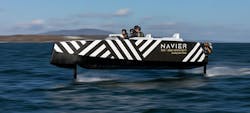Is the Boating World Ready to Ditch the Diesel?
What you'll learn:
- How hydrofoiling can help reduce range anxiety.
- The latest electric boat developments from Candela, Navier, and Pure Watercraft.
- What's a variable-speed marine generator?
A traditional 7.5-m petrol-powered boat consumes an estimated 15X more fuel than a family car. Multiply that number by the amount of boats worldwide and it’s clear that the notion of traditional combustion-engine boats isn’t sustainable.
Fortunately, technology may have finally caught up to the problem, with more than two dozen builders having recently launched new electric runabouts. Surveys show that boaters are no longer especially concerned about the mix of water and electricity in an all-electric boat, as boat manufacturers have taken the necessary steps to safeguard an electric boat’s battery system.
Even the iconic Maid of the Mist Niagara Falls boat tours, which have long been described as electric, is now a factual statement. The catamaran-style boats are all-electric, and it’s a gross understatement to say that these vessels regularly get a considerable water shower from the falls they pass by.
Like their land-based cousins, however, range remains a restricting factor. Range on the water depends on the hull, propeller, speed, and number of battery packs in use.
Hydrofoiling
To combat range anxiety, “flying” electric boats with underwater airplane-like “wings” have been developed. Anyone who has watched America’s Cup boats in action will know how hydrofoiling has revolutionized boat performance. Hydrofoiling is used to get around the fact that batteries run out of power quickly when tasked with pushing water out of the way to move forward. It basically takes advantage of the fact that water can cause much of the boat to lift above the surface, while the propulsion part stays below, attached by fins.
For the first time, the America's Cup was sailed with foiling boats. Integrating surface-piercing foils allows for unprecedented speed and comfort, but it raises significant design challenges regarding control and safety. The sailing world was turned upside down by a 72-ft. catamaran “flying” in the Hauraki Gulf. Later, in 2018, the publication of the AC75 Class Rule marked the beginning of a new sailing era.
The engineering and sailing techniques needed to get the AC75 to “fly” were completely different from anything seen before. The foiling monohulls to be used to challenge for the America’s Cup in Barcelona in 2024 will be slightly different, with rules being tweaked partly to improve light wind performance and reduce crew numbers from 11 to 8.
Candela’s C-8
Instead of punching its way through the waves with a bigger engine and brute force, the electric C-8 from Swedish builder Candela depends on dramatically improved efficiency via a propulsion pod motor optimized for hydrofoils (Fig. 1). The foils mean that the boat is more efficient because it has less drag and isn’t particularly vulnerable to rough sea conditions.
A day cruiser equipped with Candela’s electric hydrofoil system reduces water friction by 80%. This is a craft that leaves no wake behind. Powered by the same 69-kWh pack as the Polestar 2 electric performance car, these batteries bring dc charging to the table for longer electric range with faster charging times. At 22 knots (27 mph), the lithium-ion-battery boat has a range of 50 nautical miles. At 20 knots, Candela C-8 uses only about 21 kW of power.
At the heart of the technology is Candela’s C-Controller, an onboard computer that uses inputs from a variety of sensors to adjust the boat’s hydrofoils in real-time to balance the craft in waves, wind, and different loads. Once the Candela C-8 is up on its hydrofoils, the onboard flight-control computer automatically regulates the angle of attack of the hydrofoils 100 times per second.
Featuring a 100% carbon fiber hull, the C-8 is powered by the Candela C-POD, a specially designed, 55-kW direct-drive electric motor that’s said to require no scheduled maintenance for 2,000 hours. The hydrofoils can be retracted when entering shallow harbors or for trailering. And in extreme wave heights, the boat can be driven as a traditional planing hull craft, albeit less efficiently. The C-8 has a draft of fewer than two feet with the hydrofoils retracted. The production-version C-8 will sleep two adults and two children.
Navier’s N30
Just as with their land-based siblings, autonomous operation is making its way into water-borne craft. Recently, Navier showed off what it’s calling the first ever auto-docking feature for a hydrofoil electric boat.
The N30 auto-docking system uses computer vision and additional sensors to estimate the location of the boat with respect to the selected slip while compensating for external perturbations such as wind as well as avoiding obstacles. Navier’s N30, will now allow boaters the ability to dock with single click.
According to the company, the independently steerable twin motors in the N30 can perform docking maneuvers such as pure translational and turning movements. N30 boasts a range of 75 miles (65 nautical miles or 121 km) and speeds of up to 35 knots (40 mph or 64 km/h), but not at the same time (Fig. 2).
Pure Watercraft’s Pontoon
If the aforementioned electric craft seem a bit sports-centric, Pure Watercraft’s electric pontoon boat, created in collaboration with General Motors (GM), is agreeable and well-suited for enjoying all-day cruising and quiet, hassle-free boating. Powered by GM’s automotive battery pack and single or twin Pure Outboard motors, this fully integrated electric boat accommodates up to 10 passengers.
Pure’s outboard motor is said to be up to 70% efficient overall, measured as the percentage of energy from the battery pack used for propulsion (not just the motor efficiency). Typical electric outboard motors range from 35% to 55% overall efficiency; gas outboards are 5% to 15% overall efficient, and electric trolling motors (marine propulsion units that include an electric motor, propeller and control system, and is affixed to an angler's boat) are 18% to 22% overall efficient.
Greater efficiency results in more energy being converted into propulsive power and fewer energy losses. Put another way, this means less energy is required to travel a given distance, resulting in fewer batteries needed on board—saving space, weight, and battery costs. Twin Pure outboards have a 26-mile range at top speed (23 mph); 120 miles at 5 mph. Single outboard versions can go 32 miles at top speed (14 mph), 120 miles at 5 mph.
Up to 32 battery packs can be connected in parallel by simply connecting each additional pack with a single cable. Adding another pack will increase the range of travel available; for most recreational uses, one or two battery packs will be sufficient. The system can only be used with the Pure Watercraft battery pack.
To keep battery packs in the right temperature range, an internal liquid-cooling system is employed that pulls heat out of the cells and exhausts the heat into the air using internal fans. The liquid doesn’t need to be replaced or topped up. The batteries also have a heating mechanism to warm them in very cold conditions.
The Pure Watercraft battery pack is designed for a useful life of at least 10 years or 1,000 full charge/discharge cycles. The packs are charged using the Pure Watercraft’s charger, which can plug into any 120- or 240-V, 50-A outlet. The Pure charger is portable, has a carrying handle, and weighs 24 lbs. Its dimensions are 16.33 in. long × 10.46 in. wide × 5.23 in. tall. The charger can be kept on the dock, in the garage, or on the boat. It will recharge the system from half to full charge at 120 V in 4.5 hours per battery pack, or at 240 V in 90 minutes with one or two battery packs.
Electric Revolution is Fully Underway
Volvo Penta has launched a new range of variable-speed marine generator sets—a key enabler for electric propulsion for marine vessels. These generator sets are designed for hybrid and electric applications. A typical installation will have a variable-speed marine generator set installed to power electric drives with or without battery packs.
The generator makes it possible to build vessels with smaller battery banks and charge them while on the move, which makes the switch to hybrid-electric marine propulsion more cost-efficient and accessible today. The modular installation also creates the option of using the minimum number of engines to deliver the power needed so that the marine generator sets are able to run in the efficiency sweet spot.
As electric boating grows in popularity, the need for electric boat charging outlets also will grow. Virtually every marina has an electrical tower feeding shore power, which in time will abrogate charging concerns for consumers.
Dockside rapid-charger company Aqua Superpower now has expanded into the U.S. with the installation of an electric boat charger in the marina in Lake Tahoe. The dc chargers range in power from 25 to 150 kW and allow an electric boat to charge in 20 to 90 minutes.
The London-based company already has 150 fast chargers installed across the Cote d’Azur, the Italian Riviera, Spain, Portugal, the UK, Sweden, and Canada. Norway is installing a network including 150-kW superchargers, and in Venice, electric mooring posts along the canals will service expanding marine electrification there.
Monaco Energy Boat Challenge
From July 3-8, 2023, the 10th edition of the Monaco Energy Boat Challenge will take place. This unique event—the only one of its kind in the world—is organized by the Yacht Club de Monaco in partnership with the Prince Albert II of Monaco Foundation, with support from BMW, Credit Suisse, SBM Offshore, and the shipyard Oceanco. Equipped with ac chargers, it will have the capacity to recharge 20-plus boats at the same time with a fast, reliable supply.
Aqua SuperPower will launch its first E-Dock for this event. The 16-nautical-mile E-Boat Rally will leave from Monaco to call into Cala del Forte in Ventimiglia, Italy, where participants can recharge and visitors will be able to see the boats up close, before they return to the Principality. Best of Innovation prizes will be up for grabs in four categories: alternative-energy system (battery, fuel cells, etc.), alternative-propulsion system, new materials, and innovative and sustainable yacht/boat.


